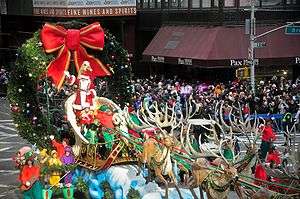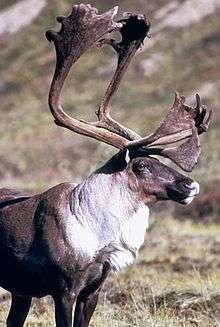Santa Claus's reindeer
.jpg)
Santa Claus's reindeer form a team of flying reindeer traditionally held to pull the sleigh of Santa Claus and help him deliver Christmas gifts. The commonly cited names of the reindeer are Dasher, Dancer, Prancer, Vixen, Comet, Cupid, Donner, and Blitzen. They are based on those used in the 1823 poem "A Visit from St. Nicholas" (commonly called "The Night Before Christmas"), which is arguably the basis of the reindeers' popularity.[1]
The enduring popularity of the Christmas song "Rudolph the Red-Nosed Reindeer" has led to Rudolph often joining the list.
List of reindeer

In traditional lore, Santa Claus's sleigh is led by eight reindeer: Dasher, Dancer, Prancer, Vixen, Comet, Cupid, Dunder (variously spelled Donder and Donner), and Blixem (variously spelled Blixen and Blitzen), with Rudolph being a 20th-century inclusion.[2][3]
The names Dunder and Blixem derive from Dutch words for thunder and lightning, respectively.
Origins
Eight reindeer

The 1823 poem by Clement C. Moore "A Visit from St. Nicholas" (also known as "The Night Before Christmas" or "'Twas the Night Before Christmas") is largely credited for the contemporary Christmas lore that includes the eight flying reindeer and their names.[4]
The relevant segment of the poem reads:
When, what to my wondering eyes should appear,
but a miniature sleigh, and eight tiny rein-deer,
with a little old driver, so lively and quick,
I knew in a moment it must be St. Nick.
More rapid than eagles his coursers they came,
And he whistled, and shouted, and call'd them by name:
"Now, Dasher! Now, Dancer! Now, Prancer, and Vixen!
"On, Comet! On, Cupid! On, Dunder and Blixem!
"To the top of the porch! to the top of the wall!
"Now dash away! dash away! dash away all!"As dry leaves that before the wild hurricane fly,
So up to the house-top the coursers they flew,
When they meet with an obstacle, mount to the sky;
In An American Anthology, 1787–1900, Edmund Clarence Stedman reprints the 1844 Clement Clarke Moore version of the poem, including the German spelling of "Donder and Blitzen," rather than the original 1823 version using the Dutch spelling, "Dunder and Blixem."[1] Both phrases translate as "Thunder and Lightning" in English, though German for "thunder" is now spelled Donner, and the Dutch words would nowadays be spelled Donder and Bliksem.
Rudolph (the red-nosed reindeer)
Rudolph's story was originally written in verse by Robert L. May for the Montgomery Ward chain of department stores in 1939, and published as a book to be given to children in the store at Christmas time.[5] According to this story, Rudolph's glowing red nose made him a social outcast among the other reindeer. Santa Claus' worldwide flight one year was imperiled by severe fog. Visiting Rudolph's house to deliver his presents, Santa observed Rudolph's glowing red nose in the darkened bedroom and decided to use him as a makeshift lamp to guide his sleigh. Rudolph accepted Santa's request to lead the sleigh for the rest of the night, and he returned home a hero for having helped Santa Claus.
Rudolph's story is a popular Christmas story that has been retold in numerous forms, most notably a popular song, a stop motion television special and an animated feature film. The television special departed significantly from Robert L. May's original story, depicting Rudolph as Donner's son, who lived among Santa Claus' reindeer from birth. In 1998, a film titled Rudolph the Red-Nosed Reindeer: The Movie was released that depicted Rudolph as Blitzen's son.
Portrayals

Although little information regarding the reindeer is disclosed in The Night Before Christmas, this has only allowed others to contribute to the backgrounds and folklore regarding them in other works (often portraying them with features more common to other species of deer or bovid). There is very little continuity between the various authors of reindeer-related works, resulting in widely varying depictions from author to author; this is further compounded by copyright, which makes crossovers between different authors' works more difficult. Some have even created extra reindeer, but the only case so far in which another's addition to the traditional group achieved general acceptance in common parlance was in the case of Robert L. May's creation of "Rudolph the Red-Nosed Reindeer".
Since the original poem, other books, movies, and music have contributed to the Christmas reindeer lore. The 1994 version of the film Miracle on 34th Street, for example, asserts that reindeer can only fly on Christmas Eve. Similarly, the famous 1964 Rankin/Bass stop-motion special on Rudolph asserts that Rudolph is the son of Donner (the 1998 movie has him instead as Blitzen's son).
In Prancer, a 1989 family film starring Sam Elliott, Cloris Leachman and Rebecca Harrell, directed by John D. Hancock, an apparently wild reindeer is hurt in a traffic accident, and nursed by a young girl who believes him to be Prancer. The end of the film suggests that the reindeer may be the Prancer.
Additional reindeer
Several literature, television, film and music pieces have made references to other reindeer. In many cases, these are explicitly related to other reindeer already in the fleet; however, these portrayals are usually never deemed as official and are constantly being rewritten and altered. The only case in which an addition to the team devised by another was in the case of the famous "Rudolph the Red-Nosed Reindeer" by Robert L. May, gaining an iconic and traditional status.
In comics
- The comic strip Over the Hedge (which debuted in 1995), added a character named Ralph, the Infrared Nosed Reindeer, who is Rudolph's brother and has a nose that emits infrared radiation.
In film
- The feature film, Rudolph and Frosty's Christmas in July (1979), features an antagonist reindeer named Scratcher.
- The feature film, Rudolph the Red-Nosed Reindeer: The Movie (1998), introduces Mitzi as Rudolph's mother and Blitzen's wife (as opposed to the Rankin/Bass version, wherein Donner is Rudolph's father and his mother is unnamed). It also features two other reindeer Rudolph's love interest Zoey and his cousin and rival Arrow, the latter of whom is Cupid's son.
- Chet is a young reindeer in training who is introduced in the 2002 feature film, The Santa Clause 2 (2002).
- In the film Blizzard (2003), the title character is Blitzen's daughter. The film also includes Delphi, Blitzen's mate and Blizzard's mother.
- In the 2011 film Arthur Christmas, Arthur along with his grandfather Grandsanta use a team of reindeer who are the great-great-grandchildren of the original eight, to pull Grandsanta's old sleigh. Grandsanta is also shown to own a nameless elderly reindeer but it is never said if he is one of the original reindeer or not.
In literature
- L. Frank Baum's story The Life and Adventures of Santa Claus (1902) includes a list of ten reindeer, none of which match the names of the versions found in "A Visit from St. Nicholas". Flossie and Glossie are Santa's principal reindeer in Baum's story. Claus gathers eight more reindeer, named in rhyming pairs: Racer and Pacer, Fearless and Peerless, Ready and Steady, Feckless and Speckless.
In music
- "Run Rudolph Run" (1958), recorded by Chuck Berry a popular Christmas-rock song about Rudolph
- "Shadrack The Black Reindeer", was recorded by Loretta Lynn for a 1974 Christmas single.[6]
- Joe Diffie's album Mr. Christmas (1995) features the song "Leroy the Redneck Reindeer".[7]
In television
- The Rudolph (1964) special features Fireball as one of several reindeer trying out for the sleigh team. Fireball is the son of Blitzen; another reindeer is said to be the son of Dasher and struggles at flying, along with two other reindeer fawns of the same age. A young fawn named Clarice is also featured and eventually becomes Rudolph's love interest. Donner is portrayed as Rudolph's father.
- In the animated television special Dr. Seuss' How the Grinch Stole Christmas! (1966), the Grinch disguises his dog Max as a reindeer.
- "Lightning", from the Sesame Street Christmas special, "Elmo Saves Christmas" 1996), is a reindeer-in-training.
- In the TV special Robbie the Reindeer (1999), the eponymous Robbie is ostensibly assumed to be the son of Rudolph. His special feature is his nose, which has supernatural powers that allow him to jump and fly farther and faster than most reindeer.
- The South Park Christmas special "Red Sleigh Down" (2002), Santa's sleigh is shot down over Iraq, killing the eight famous reindeer. The protagonists go to rescue him with Santa's backup team: Steven, Fluffy, Horace, Chantel, Skippy, Rainbow, Patches and Montel.
- In the TV special Holidaze: The Christmas That Almost Didn't Happen (2006), Rusty is said to be Rudolph's younger brother. Unlike the other reindeer, Rusty is flightless, so instead assists Santa and the other reindeer from air traffic control.
- The TV series, My Friends Tigger & Pooh, introduced a special Super Sleuth Christmas Movie (2007) that included Vixen's husband Frost and daughter Holly.
- The television special, The Flight Before Christmas (2008), features Niko, a wild reindeer whose mother Oona claims he was fathered by one of Santa's team. After a falling out with his herd, he runs away to try to meet his father, learning to fly in the process. His father turns out to be Prancer. A sequel titled Little Brother, Big Trouble: A Christmas Adventure was released and featured Niko gaining a stepbrother named Jonni, after Oona marries a reindeer named Lenni.
- Thrasher is a top-secret, oversized reindeer introduced in the Disney TV special Prep & Landing (2009). He leads the titular "prep and landing" team of elves in a sleigh ahead of Santa Claus' main sled and is Dasher's second cousin.
In video games
- The Animal Crossing games feature a reindeer named "Jingle", who appears in the player's village on Toy Day (the games' version of Christmas Eve).
See also
| Wikimedia Commons has media related to Santa Claus's reindeer. |
References
- 1 2 Moore, Clement C. (2 December 1823). "An Account of A Visit from St. Nicholas". Troy Sentinel. p. 2. Retrieved 12 December 2008.
- ↑ Jeffers, Harry Paul (2001). Legends of Santa Claus. Minneapolis: Lerner Publications. p. 85. ISBN 9780822549833.
- ↑ Triefeldt, Laurie (2008). People & Places: A Special Collection. Sanger, CA: Quill Driver Books. p. 77. ISBN 9781884956713.
- ↑ Siefker, Phyllis (1997). Santa Claus, Last of the Wild Men: The Origins and Evolution of Saint Nicholas, Spanning 50,000 Years. Jefferson, NC: McFarland & Company. p. 4. ISBN 0-7864-0246-6.
- ↑ Wook Kim (17 December 2012). "Yule Laugh, Yule Cry: 10 Things You Didn't Know About Beloved Holiday Songs (With holiday cheer in the air, TIME takes a closer look at some of the weird stories behind our favorite seasonal tunes)". Time. – "Rudolph the Red-Nosed Reindeer" (p. 3)
- ↑ "Loretta Lynn - Shadrack the Black Reindeer/Let's Put the Christ Back in Christmas (Vinyl)". Discogs. Retrieved 30 April 2016.
- ↑ Stephen Thomas Erlewine. "Mr. Christmas - Joe Diffie - Songs, Reviews, Credits, Awards - AllMusic". AllMusic. Retrieved 17 December 2014.
Further reading
- Puckett, Catherine & Landis, Ben (15 December 2014). "The Other 364 Days of the Year: The Real Lives of Wild Reindeer Categories: Biology and Ecosystems". U.S. Geological Survey.